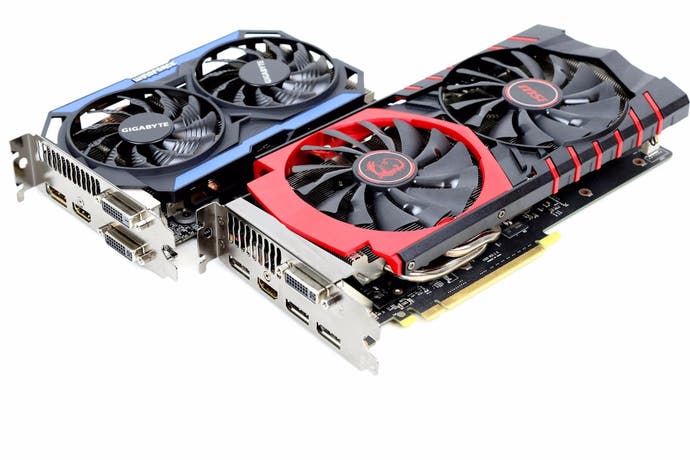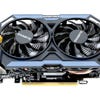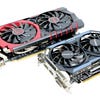Nvidia GeForce GTX 960 2GB vs 4GB review
How much VRAM do you actually need?
We have unfinished business with Nvidia's GTX 960. On launch, we lauded its power efficiency, overclocking and cutting-edge media acceleration but we had two issues: firstly, there was no clear win over the competition in terms of performance, and secondly, it was a 2GB card in a world where console-level visuals were starting to demand a 3GB minimum. However, in line with its AMD counterpart - the R9 380 - 4GB variants are now available, and we've finally acquired one.
The card in question is Gigabyte's GV-N960OC-4GD and we bought it ourselves from Amazon for £160. And that price-point is significant, because it's pretty much the same cost as many of the other GTX 960s on the market - cards that only feature the standard 2GB allocation. Which begs the question, is there any sign of obvious cost-cutting on this particular model? Well, the truth is that in direct comparison with our existing 2GB SKU - MSI's Gaming 2G model - it's actually a bit of a peach. Physically, the card is much smaller, making it a really good, cheap card for a relatively powerful small form-factor PC, yet there is no obvious increase in heat generation or fan noise. Even on an open air test bed, there's no sign of the dreaded 'coil whine'.
Build quality looks good, the card is more understated than many of its competitors, and even with its diminutive dimensions, there's no real loss of functionality. Gigabyte's model retains the SLI connectivity, and feature dual DVIs, HDMI and DisplayPort IO - probably more useful for a card in this price range than the three-way DisplayPort, DVI and HDMI set-up of our existing MSI Gaming 2G card.
In terms of power delivery, it uses the GTX 960's standard six-pin input, making it widely compatible with more power supplies than its AMD equivalent, the R9 380 (typically requiring two). The MSI card has an eight-pin input for higher power delivery, but when it came to overclocking, that really seemed to make no odds. Nvidia reckons that even on a standard cooler, the GTX 960's fully enabled GM206 processor will overclock nicely, boosting to around 1450MHz. We got the Gigabyte card up to 1475MHz vs 1500MHz on the MSI model - a difference that has no noticeable impact on real-world gaming.
Buy the graphics cards tested on this page from Amazon with free shipping:
However, at stock settings, the Gigabyte card is slower than our existing MSI example. Base clock is set at 1190MHz vs 1216MHz, and we suspect that the MSI card has more aggressive boost, resulting in slightly lower frame-rates on our new 4GB card. But there's really nothing at all to stop you dipping into your overclocking tool of choice (we recommend MSI Afterburner) and upping the core clock by, say, 50MHz and that will more than compensate. In truth, that's barely scratching the surface of what this card can do from an overclocking perspective.
So on a general level, what kind of performance can you expect from the GTX 960? When we first reviewed it, there was no knockout win in terms of its gaming throughput - and things have changed since then, and arguably, not for the better. AMD has refreshed its R9 285, essentially overclocking it and backing it with improved drivers. The result is the R9 380, which is undoubtedly the faster card.
We like to get a handle on the gaming credentials of any given GPU by running it through the Crysis 3 gameplay challenge - a run-through of the Welcome to the Jungle stage, which on high and very high presets, remains highly demanding. Our aim here is to hit 1080p at as close to a sustained 60fps as possible, matching the resolution and refresh rate of the most common type of gaming display in use today (according to the Steam hardware survey, at least).
| Crysis 3 1080p60/V-Sync Gameplay | GTX 960 | R9 380 | R9 280 |
|---|---|---|---|
| Lowest Frame-Rate | 40fps | 41fps | 40fps |
| Dropped Frames (from 18650 total) | 689 (3.7%) | 539 (2.9%) | 840 (4.5%) |
Dropping down to the high preset to sustain 60fps as much as we can, we pit the GTX 960 against the R9 380 and our favoured card in this category (before AMD discontinued it) - the R9 280. The results demonstrate that there is the same ballpark performance, but the latest AMD card is better at preserving peak frame-rates. The GTX 960 sits in the middle, faster than the old Radeon but not quite as quick as the latest model.
Now, the R9 380 doesn't have much in the way of overclocking headroom available (1-3fps extra on seven of our eight test games at 1080p, with Tomb Raider doing best, rising by 5fps), so we were interested in revisiting GTX 960 performance on two counts. Firstly to see if the easily overclockable Nvidia card can catch up or exceed its competitor once the OC was in place, and secondly - and rather more importantly - to see the impact that 4GB of VRAM makes. On the first count, the answer is broadly positive - the GTX 960 either draws level with R9 380, or mildly exceeds it, but there's no knockout blow against the AMD counterpart. The second point is a little more complex.
The TL;DR read version is this: watch the video. Nvidia's memory management is typically more robust than its AMD counterpart, meaning that its 2GB tends to go further (look at Far Cry 4 for the best example of this). For the most part, latency spikes (stutter) where VRAM is maxed are smoothed out, producing improved performance that belies the frame-rate averages. However, there is a night and day difference with an ultra-high Assassin's Creed Unity - there's a 30 per cent boost to overall performance with a 4GB GTX 960, making the top-end experience attainable at 30fps on what is a relatively inexpensive card. Elsewhere, gains are more limited, if not non-existent. Buying a 4GB card at this point remains an insurance policy of sorts - something that pays off spectacularly occasionally, especially in sub-optimal PC ports (Batman: Arkham Knight, we're looking at you).
| 1920x1080 (1080p) | R9 380 2GB | R9 380 4GB | GTX 960 2GB | GTX 960 4GB | GTX 960 4GB OC |
|---|---|---|---|---|---|
| Assassin's Creed Unity, Ultra High, FXAA | 32.8 | 37.1 | 26.7 | 34.5 | 39.0 |
| Battlefield 4, Ultra, 4x MSAA | 47.9 | 47.8 | 49.4 | 47.6 | 53.6 |
| Crysis 3, Very High, SMAA T2x | 50.3 | 49.8 | 47.2 | 46.2 | 51.6 |
| Far Cry 4, Ultra, SMAA | 50.7 | 53.8 | 48.1 | 47.2 | 53.1 |
| Shadow of Mordor, Ultra, Medium Textures, FXAA | 62.7 | 64.1 | 52.8 | 52.2 | 56.9 |
| Ryse, High, SMAA | 47.8 | 49.5 | 42.4 | 41.1 | 46.5 |
| Tomb Raider, Ultimate, FXAA | 69.5 | 70.0 | 66.9 | 65.2 | 72.5 |
| The Witcher 3, High, No HairWorks, Custom AA | 49.7 | 49.2 | 47.3 | 47.2 | 53.0 |
We can't recommend the GTX 960 or the R9 380 for high-end gameplay at 1440p - while most of the numbers below are north of the 30fps threshold, it's important to remember that they are averages. All of the games tested here with the exception of Shadow of Mordor and Tomb Raider drop into the low-20s at their lowest points - and those are the moments you'll remember most in your gameplay sessions. Bearing in mind that 2560x1440 represents a 77 per cent increase in resolution over 1080p, you're going to need some fairly aggressive settings tweaks in the downward direction to get today's demanding titles to run well at this high pixel count.
Still, the games that tested the 2GB VRAM limit first time around are even more challenging now, but mostly for the R9 380, where even dropping Assassin's Creed Unity down from ultra high to high settings still results in big wins for AMD's 4GB card compared to its 2GB version. Once again confirming that Nvidia VRAM goes further, the performance difference is much lower between the two SKUs, though 4GB remains preferable.
Just to reiterate the point, on both tables you'll note that the 4GB GTX 960 is marginally slower than the 2GB version in most cases. This is not down to the VRAM difference - it's because of the differing factory overclocks between the 2GB MSI card we had to test and the 4GB Gigabyte card. On aggregate across our eight tests, the 4GB R9 380 is around ten per cent faster than its GTX 960 counterpart, but with the overclock in place, the Nvidia card has an average 1.7 per cent uplift compared to its rival (obviously though, the R9 380 itself can be pushed beyond this, but not substantially). At 1440p, the gap widens - the R9 380 is 15 per cent faster when the 4GB cards are compared directly.
| 2560x1440 (1440p) | R9 380 2GB | R9 380 4GB | GTX 960 2GB | GTX 960 4GB |
|---|---|---|---|---|
| Assassin's Creed Unity, High, FXAA | 27.3 | 31.4 | 25.2 | 26.2 |
| Battlefield 4, Ultra, 4x MSAA | 31.6 | 31.5 | 31.9 | 31.0 |
| Crysis 3, Very High, SMAA T2x | 31.6 | 31.3 | 28.3 | 27.7 |
| Far Cry 4, Ultra, SMAA | 36.5 | 39.5 | 33.7 | 32.8 |
| Shadow of Mordor, Ultra, Medium Textures, FXAA | 46.5 | 46.3 | 37.8 | 36.8 |
| Ryse, High, SMAA | 33.0 | 35.6 | 30.2 | 29.2 |
| Tomb Raider, Ultimate, FXAA | 47.7 | 47.7 | 42.2 | 41.2 |
| The Witcher 3, High, No HairWorks, Custom AA | 33.5 | 33.2 | 30.4 | 31.0 |
Let's round off the analysis by taking a look at power consumption and overclocking. We have a particular stress test here: the end of the Crysis 3 Welcome to the Jungle stage features an area of the level rich in geometry and bathed in performance-sapping alpha effects. It causes a spike in power consumption we've not seen in a repeatable scenario in any other game. We use this to test peak system power consumption, and also to stress-test our overclocking. The chances are you can push this card further, but we're interested not just in maximum frequencies but also in longer term stability.
We were stable with an additional 160MHz added to the core and 450MHz to the onboard GDDR5 taking us very close to a full 8000gbps of bandwidth. That's slightly lower in terms of the core compared to the MSI Gaming 2G model we tested, but had no noticeable impact on everyday gaming - we were still regularly boosting to an impressive 1475MHz. That said, this is lower than other Maxwell cards, where +200MHz to the core is usually our starting point. On average, the Gigabyte GTX 960 added 12 per cent to its performance with the overclock in place, and bearing in mind that the card remained cool and quiet with no massive spike in power draw, that's a good result.
As expected, it's good news in terms of overall power consumption - the GTX 960 is considerably more power-efficient than the R9 380, and overclocking adds a mere 22W to consumption. On an open air test-bed, GPU temperatures remained in the 60 degrees Celsius range, even with the card overclocked. Overall consumption in the stress test scenario hit a max of around 248W here. Bearing in mind we're using a Core i7 4790K processor, that's not bad at all. And we should say that this Crysis stress test really does put the card through the wringer - in our initial GTX 960 review, we used the Metro Last Light benchmark for power consumption testing and the result was almost 50W lower.

| R9 380 2GB | R9 380 4GB | GTX 960 2GB | GTX 960 4GB | GTX 960 4GB OC | |
|---|---|---|---|---|---|
| Peak System Power Draw | 282W | 279W | 228W | 226W | 248W |
Nvidia GeForce GTX 960 4GB - the Digital Foundry verdict
We originally characterised the GTX 960 as 'good but not great' and in performance terms, nothing has changed. Indeed, with the arrival of the R9 380, AMD has inched ahead and even with a boost overclock reaching 1475MHz, the GTX 960 still doesn't dominate. Performance is king in terms of GPU buying recommendations, but there are scenarios where other factors should be taken into account - which leads us on to why we bought this particular 4GB GTX 960 in the first place.
Eurogamer video team member Ian Higton required an upgrade for his gaming PC running an 'oldie but goodie' Core i7 920, overclocked to 3.3GHz. We swapped out the mechanical hard drive for an SSD, and replaced the 1GB Radeon HD 7850 with the Gigabyte GTX 960. Why not the R9 380? Well, it requires two six-pin PSU power inputs. The PC in question has a Corsair CX430 power supply with one six-pin PSU output, meaning that the GTX 960 offered a straight GPU swap with no cable faffing. More importantly, the onboard media block will hook up directly with whatever livestreaming set-up he's using (and failing that, Nvidia ShadowPlay is very, very good). Performance-wise, he still has GPU power that outstrips the consoles and with 4GB of VRAM, he's future-proofed as far as we can take him at a sub-£200 price-point. Overall, this package is pretty neat for £160.
It was for those reasons that we took the plunge in buying the card, but once we received it, it's clear there were plenty more good reasons for considering this product. This GTX 960 is very small - perfect for integration in a small form-factor PC or DIY Steam Machine. Combined with its excellent acoustic performance and hardware h.264/HEVC decode, the Gigabyte GV-N960OC-4GD would work beautifully in an HTPC. In short, this card may not offer all of the performance of its AMD rival (though overclocking helps a lot), but its complete feature set is accomplished, arguably it's more versatile and - for now at least - it's cheaper than 4GB versions of the R9 380.
There'll always be the sense that the GTX 960 isn't Nvidia's finest hour. The firm commands performance leadership in virtually every other market sector, and in this sense, the GTX 960 is an outlier. But fundamentally it clearly has its strengths, and the overall package offered by the Gigabyte GV-N960OC-4GD makes the most of the processor's strongest points in a highly appealing, miniaturised form factor.








